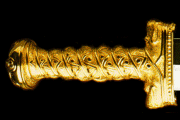Graham Phillips identifies a historical figure behind the legend of King Arthur, and searches for his capital city and his long-lost tomb.
Page 1 of 6
The Lost Tomb of King Arthur
The story of King Arthur is known throughout the world. The fabled Camelot, Sir Bedivere casting Excalibur into the lake and Arthur’s secret burial at the isle of Avalon: these are just a few of the enchanting themes in the ancient saga that historians have long considered to be pure fantasy. Now, in The Lost Tomb of King Arthur, Graham Phillips presents compelling evidence that such legends were actually based on real events. During a quest lasting over twenty-five years, he has followed a fascinating trail of historical clues showing Arthur to have been a living warrior who led the Britons around the year 500. He has discovered that the legendary Camelot, Excalibur and Avalon were based on a real city, a real sword and a real island. And, most astonishing of all, Graham has found what he claims to be the location where Arthur was finally buried. An ancient manuscript still persevered at Oxford University, Graham believes, reveals the whereabouts of King Arthur’s long-lost tomb. Not in the South West town of Glastonbury, as the popular myth maintains, but at an ancient site in the isolated countryside of central England. With the help of archaeologists employing the very the latest scientific equipment, Graham now has what he is certain is the final proof that this disregarded Dark Age text really does reveal the last resting place of the man behind the legend of King Arthur.
Please click on image to order this book.
English edition: Bear & Company 2016









